What is a food co-operative? Depending on your age, you might envision a cozy, slightly run-down food market with barrels of flour and bags of rice on the floor, around which barefoot children are running while their parents debate politics and plan social actions against “the establishment.”
Or, if you’re a generation or two younger, you might imagine a “mini-Whole Foods Market” offering perfect produce, a wide range of canned, frozen and prepackaged organic food, and Fair Trade coffee at the espresso bar.
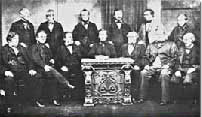
Food co-ops have always reflected contemporary culture and have changed as society changed. In 1844, when England was in the throes of the Industrial Revolution, a group of 28 cotton mill workers in Rochdale, England, pooled their resources and set up a store where they could buy food items – initially just flour, oatmeal, sugar, and butter – that they could not otherwise afford.
The principles under which the co-op was established are called the Rochdale Principles and the first food co-op in the US to follow the same principles was founded in Philadelphia in 1862. Most food co-ops today follow these principles.
Many early co-ops, fueled by Scandinavian immigrants, were established in the US in the late 19th and early 20th centuries. Primarily located in New England, the North Central states, and Northern California, they resembled the general stores of the day. The co-ops offered familiar food items along with other products and services, however as the immigrants’ ethnic identity blended into their community’s diversity, the co-ops gradually closed.
A second wave – the “old wave” – of food co-ops developed during the Great Depression, again to provide good food at a reasonable price. They grew and prospered for a period, but as their membership changed they failed or went out of the food business. Only a few survive today.
Many of the food co-ops in existence today were founded in the late 1960s through the early 1980s during a third wave – the “new wave” – of cooperative development. The number of retail food co-ops grew rapidly and by 1975 there were about 700 in operation.(1)
As these retail operations faced inflation and high interest rates, they needed to become more “business-like” and to put formal business practices in place. Many failed and by 1980 the number was down to about 350.
It was in the late 1980s and early 1990s that food co-ops began to see competition increase from natural food chains like Whole Foods, Wild Oats, and Trader Joe’s. A general conformity in the natural/organic/”healthy” frozen and packaged foods offered by retail food markets of all sizes and business models has resulted from the consolidation of organic and natural products distributors into two major companies: Tree of Life/Kehe, and United Natural Foods.
There are now more than 9,000 natural products and health food stores, including retail food co-ops. These range from very small shops (less than 1000 square feet) to the “supernaturals” (supermarkets who sell natural products and health foods) such as Whole Foods (270 stores), Trader Joe’s (350 stores), and large food co-ops like the PCC Natural Markets (9 stores), Seattle.(2) Whether full-line supermarkets or small specialty or natural food stores, there are still only about 350 active retail food co-ops across the US.(3)
Tenacious as they are, a small food co-op or natural food store is a unique operation. Let us look at a sampling of retail operations and learn how each is different and how they compete with conventional supermarkets.
(Take a virtual tour of six natural food co-ops and markets here.)
Good Food Store, Missoula MT
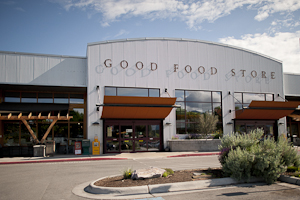 Walk into the Good Food Store and you might think you had been transported to an upscale neighborhood in a big city. Missoula – population 64,000 – is home to this unique retail experiment that has continually grown over the last 40 years.
Walk into the Good Food Store and you might think you had been transported to an upscale neighborhood in a big city. Missoula – population 64,000 – is home to this unique retail experiment that has continually grown over the last 40 years.
Started as a buying cooperative among friends looking for savings on bulk foods in 1970 and launched as a retail store in 1971, Good Food Store has evolved into a non-profit corporation. There are no members or “owners” like food cooperatives. From store profits, the corporation contributes hundreds of thousands of dollars each year in monetary donations, sponsorships and in-kind gifts to more than 250 local groups and individuals. Funds distribution for 2009 reached nearly $160,000 dollars.
To raise these funds, Good Food Store sells a wide array of carefully selected produce, beverage and grocery items, and personal care products, many of which are locally produced. As part of its mission to invest in the local community, Good Food Store sells its products at a lower than average profit margin to keep the retail prices down, provides higher-than-competitive wages and employee health insurance, and supports more than 125 local producers and processors.
Built into the store is a large classroom/kitchen where classes, demonstrations, and workshops lead by store personnel and local chefs are held to teach consumers how to purchase, manage, and prepare good food. “The more you learn about something, the more passionate you can be about it,” says Layne Rolston, Communications Director, Good Food Store. “We believe it’s important for people to learn where their food comes from, how to prepare it, and why it’s good for their health.”
Community Food Co-op, Bozeman MT
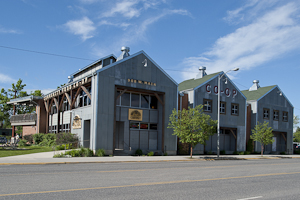 In the 1970s, a few people looking for a way to buy cheap rice could never have anticipated they were launching a substantial business that would serve a bustling community of 39,000 people.
In the 1970s, a few people looking for a way to buy cheap rice could never have anticipated they were launching a substantial business that would serve a bustling community of 39,000 people.
Bozeman’s Community Food Co-op, which employs more than 100 people, has grown to more than $12 million in sales and continues that growth at a rate of 20% per year. The Co-op now has more 16,000 member/owners, and is nationally recognized for sales per population base that are double those of most other natural food cooperatives in the country.
“Community Food Co-op was founded on the premise that we need democratic control – not corporate control – of our food system,” says Kelly Wiseman, General Manager, “so our mission includes support for local agriculture and local processors.” As a result, the Co-op created and implemented a local “Farm to Market” program that researches and rates regional producers. It is put into action as a simplified labeling system that helps consumers choose the products they want to buy according to their own values and standards.
The Farm to Market program is not a certification; it is a self-reporting system that applies standard criteria to understand the sustainability of the products labeled. Shoppers can use the designation, which is displayed as stars on tags and labels of regional offerings indicating “Organic, Local, Sustainable, and Nothing Added,” to aid in purchase decisions.
It is the relationship that Community Food Co-op has with local growers and producers – especially important in a small town – that sets them apart from other groceries and supermarkets in Bozeman.
Moscow Food Co-op, Moscow ID
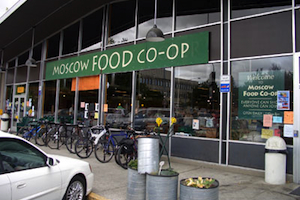 Let’s get something clear from the beginning: Moscow rhymes with Idaho, it’s not pronounced like the city in Russia, which ends with the common name of a large, domesticated ruminant.
Let’s get something clear from the beginning: Moscow rhymes with Idaho, it’s not pronounced like the city in Russia, which ends with the common name of a large, domesticated ruminant.
Like many others, the Moscow Food Co-op dates from the early 1970s, and the Co-op’s approach to retail has changed a lot over 35 years. While the store may have been more like the “traditional” food co-op in the beginning, complete with barrels and barefoot kids, this Co-op has worked hard to be “middle of the road” so everyone will feel welcome.
The intent is to be open and accessible to a broader range of shoppers. Clearly it’s working! Sales for 2009 were more than $7,270,000 and membership topped 5400.
The Moscow ID/Pullman WA retail area serves about 50,000 people and there is a lot of competition – even more now that a Wal-Mart opened in Pullman in November. So how does a small food co-op differentiate itself? It begins with community.
The Co-op has become a “third place” for many shoppers, and to encourage stronger community relationships, a Community Outreach Coordinator was hired two years ago. By combining meeting space in the store, classes and workshops, and food to share, the Co-op is building its community base.
And the outreach programs have helped build membership and sales. Kenna Eaton, General Manager, says, “Our Outreach Coordinator has done a lot of community building. People know we’re here and what we’re doing. We’ve added parenting classes, a kids club, and a grower’s market in the parking lot on Tuesdays during the growing season.”
The Co-op’s most recent community project is a joint relationship with a local gleaning group, Backyard Harvest, to teach people how to preserve food. The focus is on low-income groups who may not know what to do with gleaned and donated food.
Skagit Valley Food Co-op, Mount Vernon WA
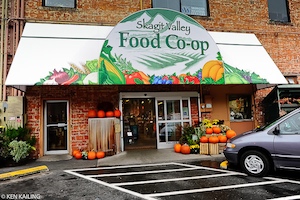 The Skagit Valley Food Co-op started in 1973 in a church basement across from the County Courthouse in Mount Vernon, a community of just over 32,000 people located about 60 miles north of Seattle.
The Skagit Valley Food Co-op started in 1973 in a church basement across from the County Courthouse in Mount Vernon, a community of just over 32,000 people located about 60 miles north of Seattle.
Like other food co-ops and buying clubs, the Co-op was a way for people to bring good food to their hometowns in an economic manner consistent with their social values. The early Co-op, run on volunteer labor, carried mostly bulk items – grains, beans, and cheese – as well as bread that members baked in collaboration with the Little Bread Company in Seattle.
Because almost all food co-ops and natural food stores – as well as an increasing number of conventional supermarkets – are offering pretty much the same packaged and prepared foods from the same distributors, it’s difficult to differentiate from the rest.
Todd Wood, General Manager, notes, “Over the last 35 years, the co-op has grown to be the unquestioned anchor of the downtown. Who would have thought it? We’re located in a fairly conservative community – there have been a lot of crunchy granola/Birkenstock jokes over the years!”
It is important to have a healthy downtown and the Co-op takes its responsibility to the community seriously. For example, a good bakery is important to a downtown area so the store now bakes a full range of cakes, pastries, cookies and other goods. Because there was no local ice cream parlor, the Co-op now makes ice cream on site and recently added an ice cream counter to the food service area.
Skagit Valley Food Co-op was the second store in Washington to have the produce department certified organic, and today the Food Co-op buys about 40% of its produce locally in season. To provide as much support as possible for local farmer-suppliers, the Co-op has offered seed loans, acted as a business incubator, and invested in suppliers.
The Co-op works hard to offer shoppers a full range of organic and good quality conventional products to meet any budget. It’s a middle path that connects the Co-op closer to the community and has made it an integral part of the city.
Real Food Market, Helena MT
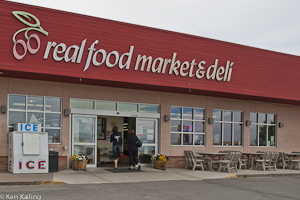 In 1975, a young man with the self-selected moniker of “Laughing Water” put his entire financial worth – $2000 – into a small storefront. And in response to the initial slow sales of his products, he spent the hours when the store was empty meditating.
In 1975, a young man with the self-selected moniker of “Laughing Water” put his entire financial worth – $2000 – into a small storefront. And in response to the initial slow sales of his products, he spent the hours when the store was empty meditating.
Lest you think that this is just a feel-good, new-age health-food store, take another look. This is a thriving retail operation generating about $6 million in sales a year and employing around 70 people.
Real Food Market is focused on all things natural and organic and is one of the few markets in the country that is completely certified organic. The store sources products from local, small, and emerging producers, and not only sells stone-ground whole-grain flour, they grind it fresh in their own mill in the store.
There is no tobacco or alcohol sold at Real Food Market. Because Laughing Water believes in natural health, not natural healing, he is more interested in optimizing good health than treating disease. The result is that he offers only products that are part of a good diet.
“I opened this store because I want to eat this way. And it gives me a platform to share ideas and impact my community,” says Laughing Water. “I’m selling a philosophy and way of life, not just food.”
Good Earth Market, Billings MT
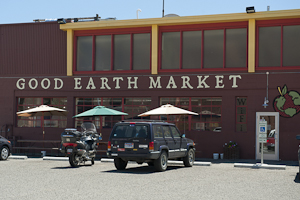 The Good Earth Market is a “Johnny Come Lately” when compared to many other food co-ops; it began as a buying club in 1987. The Market became a full-fledged retail store in 1994 and has never looked back.
The Good Earth Market is a “Johnny Come Lately” when compared to many other food co-ops; it began as a buying club in 1987. The Market became a full-fledged retail store in 1994 and has never looked back.
When a business averages double-digit growth, year after year, through good times and bad, you know they’re doing something right. Good Earth Market is not only doing things right, they’re doing the right things.
Surrounded by buttes and cliff rock, Billings (population 105,000) is in the heart of “dry farming” country where homesteaders struggled to raise enough on their claims to survive. In this rough-and-tumble town where “red necks, white socks, and Blue Ribbon beer” abound, more than 4,400 are paid members of the Co-op. Twenty full-time and six part-time employees generated retail sales in 2009 over $2,700,000.
Buying from 81 individual producers and 21 small local and regional distributors means handling more than 100 sets of invoices and payments, making for a bookkeeper’s challenge. And some are so small they are paid in cash. Nearly $700,000 (about 26% of wholesale costs) went directly to Montana producers and local distributors last year.
Items you may not find in the “usual” natural food market regularly turn up on the shelves here, including emu and buffalo meat. And for those locals who want their steaks and beer, Good Earth offers organic grass-fed beef and local micro-brews.
Retail Business Models – The Same Only Different
Natural and health food stores come in all sizes; from mega chains like Whole Foods and Trader Joe’s and mini-chain cooperatives like PCC Natural Markets to small, independent groceries with annual sales from $2 to $20 million. The independence – and, yes, the political and philosophical leanings – of these small retail stores make each one different and contributes to the diversity of the business landscape.
We are now seeing a “fourth wave” of food co-op development. When Fortune magazine highlights a co-op’s financial success, the cooperative business model gets a stamp of approval. A “new food movement” is in action and hundreds of new co-ops are in development. One of the newest, the Medford (Oregon) Food Co-op, is set to open its doors in January 2011.
– – – – – – – – – – – – – – –
(1) University of Connecticut, Food Marketing Policy Center, Haller, Lawrence. E. “Food Cooperatives.” 1995 IP9.pdf
(2) Natural Food Merchandiser’s 2010 Market Overview
(3) National Cooperative Business Association
Photos: Moscow Food Co-op, David Matusiak; All others: Ken Kailing
